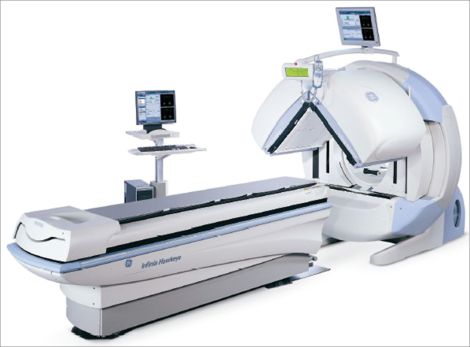A Gastrointestinal (GI) Bleed Scan is a radiological procedure performed in the Nuclear Medicine department to help evaluate and localize any potential bleeding into the gastrointestinal tract (gut).
Your doctor may order a GI bleed if you:
- Have dark or bright red blood in your stool
- Chronic anemia
Preparation
There is no preparation for a GI Bleed scan.
PLEASE INFORM YOUR DOCTOR OR THE TECHNOLOGIST IF YOU
ARE, OR THINK YOU MIGHT BE, PREGNANT OR BREASTFEEDING.
Procedure
Check-in at the Diagnostic Imaging department at the Sault Area Hospital for your appointment.
To perform a GI Bleed scan, we are required to label your red blood cells with a radioactive tracer. We begin by injecting a labelling agent (Gluceptate) into a vein to label your red blood cells. Gluceptate is a drug designed to be taken up by your red blood cells and facilitates the binding of the radioactive tracer to the red blood cells. Once injected, you will be asked to wait between 10 and 15 minutes giving time for the Gluceptate to be taken into your red blood cells. You shouldn’t feel anything from the Gluceptate injection.
Once the Gluceptate is taken into your red blood cells, you will receive an injection of a radioactive tracer. The radioactive tracer used for a GI bleed scan is Sodium Pertechnetate (Technetium 99m), and it will be taken up by the same red blood cells that took up the Gluceptate. You shouldn’t feel anything from the radioactive tracer. The two injections will combine and result in radioactive red blood cells that can be tracked through your abdomen while your images are being taken.
To take the images, you will be positioned on your back underneath our camera. The camera will be very close and above your abdominal area. Images will be taken over the course of approximately 1 hour, during which time you will be asked to lie still. The images will show any abnormal pooling of blood in your abdominal area, indicating a potential bleed in your gastrointestinal tract.
If there is no evidence of abnormal blood pooling, you will be required to return for additional pictures 3 to 4 hours after injection. If there is no abnormal blood pooling after 3 to 4 hours, you may be required to return the following day for additional imaging. The delayed imaging will allow us to evaluate over time if there is a slow blood leak.
Following your test, there are no restrictions, and you will be able to drive as you normally would. If you plan to go into the United States of America, you will set off the radiation detectors for approximately 2-3 days. We can provide a letter explaining why you are setting off the detectors; however, you will still be stopped.
Once your scan is complete, a radiologist will examine it, and a report will be sent to the ordering doctor within a week. Follow up your test with the ordering physician or your family doctor.
The Injection
The amount of radioactive tracer injected for a GI Bleed scan is small enough that there are no additional requirements or precautions to protect others from radiation exposure. The radiation exposure to you is a little more than a standard chest x-ray and less than half of that from a CT scan. Most of the injection will be cleared out of your body after 24 hours.
Allergic reactions to the materials used are extremely rare, and you should not feel anything or notice any changes from the materials injected.
The Camera
For a GI Bleed scan, we acquire the images using a gamma camera. A gamma camera is a type of radiation detector used to show where the radioactive labelled red blood cells are pooling in your abdomen. Our cameras do not emit radiation or loud noises and are not a hazard to anyone in the vicinity while acquiring. To acquire the images, we use a dual-head camera that allows us to record images from two perspectives (anterior and posterior) simultaneously. One of the camera heads will be above you and be brought in close to your abdomen. The other camera head will be brought up underneath you.

